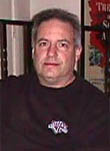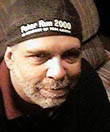|
|
This topic comprises 2 pages: 1 2
|
|
Author
|
Topic: When were the first films publicly shown?
|
|
|
|
|
|
|
|
|
|
|
Mitchell Dvoskin
Phenomenal Film Handler

Posts: 1869
From: West Milford, NJ, USA
Registered: Jan 2001
|
 posted 10-07-2003 08:25 AM
posted 10-07-2003 08:25 AM




I don't know if it was the first, but the Latham brothers first projected 70mm for paying customers on May 20,1895 in New York City. This is well documented, and before the Lumiere show.
Edision's kinetoscope was a single viewer peep show machine, using 35mm 4 perf film. The Latham brothers owned a kinetoscope franchise. The most popular films of the time were boxing matches, one round in each machine. The problem was that everybody just put money in the last machine, to see who won. Since magic lantern slide projectors were common at the time, they decided that they would make more money projecting an entire fight in a "theatre" type setting. They contacted the Edision company about building a projector, but were rebuffed. Edision's buisness model was based on selling the Kintoscopes. If one projector took the place of 20 Kintoscopes, he would make less money. The Latham brothers, being determined, hired guy named Kennedy (no relation to the polititions), who was Edison's chief engineer and the actual inventor of the Kintoscope, to moonlight and build them a projector behind Edision's back. They picked 70mm for the films size, because Edison held the patent for 35mm.
The Latham brothers did not last very long in the motion picture business. Their most lasting contribution to the industry was that the "invented" and patented the upper and lower loops, which in the book "Dictionary Of Film", are still officially called Latham Loops. Edision eventually aquired the patent when he formed the Motion Picture Patents Trust Company.
There is a very interesting book called "A Million And One Nights" by Terry Ramsaye. It is a history of the motion picture business up though 1926, when it was published. All the player in creating the industry were still alive at the time, and the author hunted them all down and interviewed them. The first editions were hand signed by Edision, even though he is not portrayed very nicely in the book.
/Mitchell
| IP: Logged
|
|
|
|
William Hooper
Phenomenal Film Handler
Posts: 1879
From: Mobile, AL USA
Registered: Jun 99
|
 posted 10-08-2003 01:25 AM
posted 10-08-2003 01:25 AM





Agreed, it does look like it's May 1895, NYC.
Terry Ramsaye *does* put the Latham machine exhibition first:
"May 20, 1895, the Griffo-Barnett fight went on exhibition to the public at 153 Broadway. It ran its flickering way about four minutes of screen time."
There was also an earlier demonstration of the Latham machine, not to the public:
"On the afternoon of Sunday, April 21, 1895, Woodville Latham gave a demonstration of his projection machine to reporters."
Film size was closer to 70mm. From the development:
"Since he wanted a larger picture to let more light through to the screen, Latham had to abandon the use of Edison's little Kinetoscope films and plan the building of a bigger camera, an amplified edition of Edison's Kinetograph."
The machine used at the May 20, 1895 exhibition:
"This machine differed from the previous projection efforts of Dickson's experiments in Room Five at Edison's laboratory in only one detail, the size of the film. One frame of the Latham picture contained approximately twice the area of one frame of the Edison film."
"The Latham machine was still merely an enlarged Kinetoscope arranged to present a picture by transmitted light on the screen, instead of viewing through a lens set in a peep hole. It was in truth not much of a contribution to the art of the motion picture. It is of historical significance to-day only because it was an expression of the effort toward the screen, and because it did for peculiar reasons, to be later revealed lead to a significance for the name of Latham out of proportion to the mechanical and scientific attainment of the Latham effort."
Mention is also made that it ran the film from reels, instead of a spool bank like the Kinetoscopes. Also, earlier the Edison machine is described by Edison, recollecting 1891 in 1924:
"This screen was five feet square. Geneva stop was probably badly made, as the picture was quite unsteady."
The New York Sun reported on the Latham's May 20, 1895 exhibition:
"The whole picture on the screen yesterday was about the size of a standard window sash, but the size is a matter of expense & adjustment."
That's about a yard or less, it can only be speculated as to the reporter's skill of estimation of area.
Ramsaye notes later in the chapter:
"Meanwhile the problem of screen projection was not so nearly solved as might be surmised at theis point. The pictures which the Latham machine projected were highly imperfect and unsatisfactory."
By 1925 standards, to boot. The one Edison's man (Dickson) was working on in the shop was not acceptable for use, etither. It looks like the Lathams' was sort of a public showing of a prototype that Edison would not have yet deemed acceptable.
It was Armat who developed the first practical, acceptable projection device.
| IP: Logged
|
|
|
|
|
|
|
|
William Hooper
Phenomenal Film Handler
Posts: 1879
From: Mobile, AL USA
Registered: Jun 99
|
 posted 10-09-2003 06:51 AM
posted 10-09-2003 06:51 AM





The glass plate camera is cool.
I should have pointed out that the technical difference between the Latham/Dickson (Edison) machines & what Ramsaye called Armat's first, successful, practical, etc. projection machine was... the Armat machine had an intermittent. The other projectors, like the Kinescope, just ran the film constantly past the light & lens, with a shutter of a disc with a slot cut in it to put up an image as it sped past. The Armat machine was reviewed by the press as not having imperfections they had seen before from projection devices - jerkiness, blurring, etc. Imagine the ghosting on those intermittent-less machines!
Ramsaye points out that it is odd that ecah of the inventors of the projectors took the longest time to come up with solving the problem with an intermittent - because each of the intermittent-using projector-inventors had *already* been using an intermittent in cameras they had constructed to take pictures for their projectors! The inventors themselves remarked how odd it was that it took so long for them to make the connection. And some - like Latham & Dickson at Edison - never did. Sitting there taking their *pictures* with a camera they'd constructed themselves, incorporating an intermittent movement.
| IP: Logged
|
|
|
|
|
|
|
|
|
|
All times are Central (GMT -6:00)
|
This topic comprises 2 pages: 1 2
|
Powered by Infopop Corporation
UBB.classicTM
6.3.1.2
The Film-Tech Forums are designed for various members related to the cinema industry to express their opinions, viewpoints and testimonials on various products, services and events based upon speculation, personal knowledge and factual information through use, therefore all views represented here allow no liability upon the publishers of this web site and the owners of said views assume no liability for any ill will resulting from these postings. The posts made here are for educational as well as entertainment purposes and as such anyone viewing this portion of the website must accept these views as statements of the author of that opinion
and agrees to release the authors from any and all liability.
|

 Home
Home
 Products
Products
 Store
Store
 Forum
Forum
 Warehouse
Warehouse
 Contact Us
Contact Us




 Printer-friendly view of this topic
Printer-friendly view of this topic
















